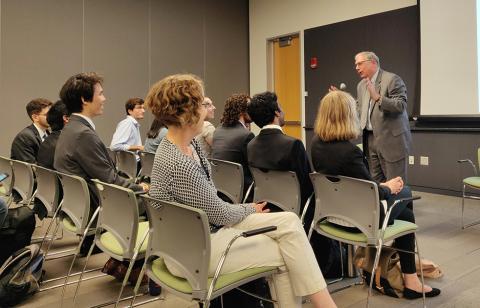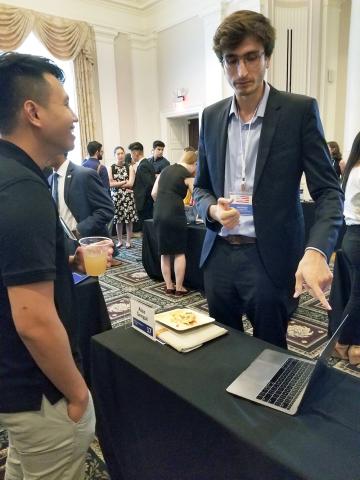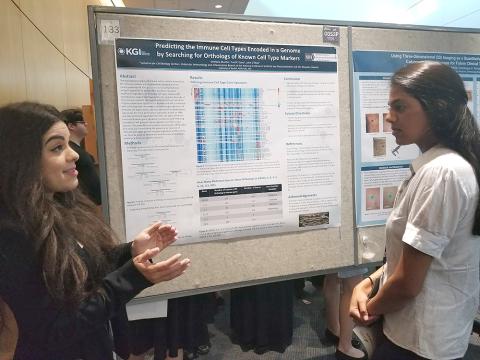Summer Students Tackle Data Challenges

Photo: Chris Kuang, Coding It Forward
Every summer, hundreds of excited students arrive in Bethesda to engage in a valuable experience working as an NIH student intern or fellow. Students bring a variety of scientific expertise, eager to see what their future may hold and how they can apply their talents to biomedical problems.
This summer brought a unique group of fellows to campus—21 data-savvy students with computational and technology backgrounds were matched with NIH mentors across 14 institutes, centers and offices. Eight undergraduates and one master’s-level student were brought on as Civic Digital Fellows through Coding it Forward, a non-profit focused on developing the next generation of technology leaders and 12 were master’s-level students brought in through the Office of Intramural Training and Education’s Graduate Data Science Summer Program (GDSSP).
The Office of Data Science Strategy organized the Civic Digital Fellows visit to NIH and worked in partnership with OITE to establish the GDSSP. ODSS also collaborated with offices across NIH to host and support these students.
Civic Digital Fellows were placed primarily in administrative or extramural-facing offices, while GDSSP fellows spent their summers in intramural research labs. The fellows spent 10 weeks at NIH applying their expertise to hands-on problems such as new challenges in artificial intelligence and data analysis, improving and automating difficult processes and developing new algorithms for classification.

Photo: Erin Walker
“There are a ton of NIH projects that are using advanced computer science fields to innovate and enhance the health work being done here,” said fellow Alaz Sengul. “I find it great that tech is being welcomed to this extent at a place where health is the primary focus.”
Sengul is a computer science major at Columbia University and spent the summer working with Drs. Andrew Miklos and Nathan Moore in NIGMS’s Office of Program Planning, Analysis and Evaluation. Sengul used natural language processing to identify, sort and categorize topics in grant applications.
“His contributions greatly aided our program staff in better understanding the ways in which we can use machine learning tools to characterize our grants portfolio and greatly expanded the capability of our team to reuse the tools he developed over his summer here,” said Miklos, section chief for data collection and analysis in the OPAE at NIGMS.
“Having Coding it Forward fellows at NIH allows groups to tap into valuable expertise not normally available within the biomedical research community,” Miklos added.
While the fellows undoubtedly brought tremendous knowledge to their labs and offices, they also had the opportunity to learn first-hand how data science skills are applied to biomedical research.
Viridiana Murillo, a GDSSP fellow, enjoyed learning how “data science is implemented [to] improve innovation, agility and speed to solve biomedical research questions here at the NIH” while using computational biology to define immune cell type gene signatures from the ImmGen database using the programming language R.

Photo: Erin Walker
Murillo is a master’s student at the Keck Graduate Institute at the University of Southern California and worked with Drs. Fred Davis and John O’Shea in NIAMS’s Molecular Immunology and Inflammation Branch. She will be returning to NIAMS in the spring to continue working on her project; several other GDSSP fellows have also extended their summer fellowships into capstone projects.
ODSS initiated these fellowships as an activity under the NIH Strategic Plan for Data Science, which provides a roadmap for modernizing the NIH-funded biomedical data science ecosystem and includes a goal of enhancing the data science and computational workforce at NIH.
“Our experiences with these summer students emphasized that having more folks with computational and other tech backgrounds in the NIH and biomedical workforces will add great value,” said Dr. Jessica Mazerik, a special assistant to NIH principal deputy director Dr. Lawrence Tabak and workforce advisor to ODSS.
Tabak agrees. After hearing their project presentations, he took a moment at the Civic Digital Fellows’ demo day to give them the ultimate compliment.
“None of you can leave,” Tabak exclaimed. “You’re all hired!”
